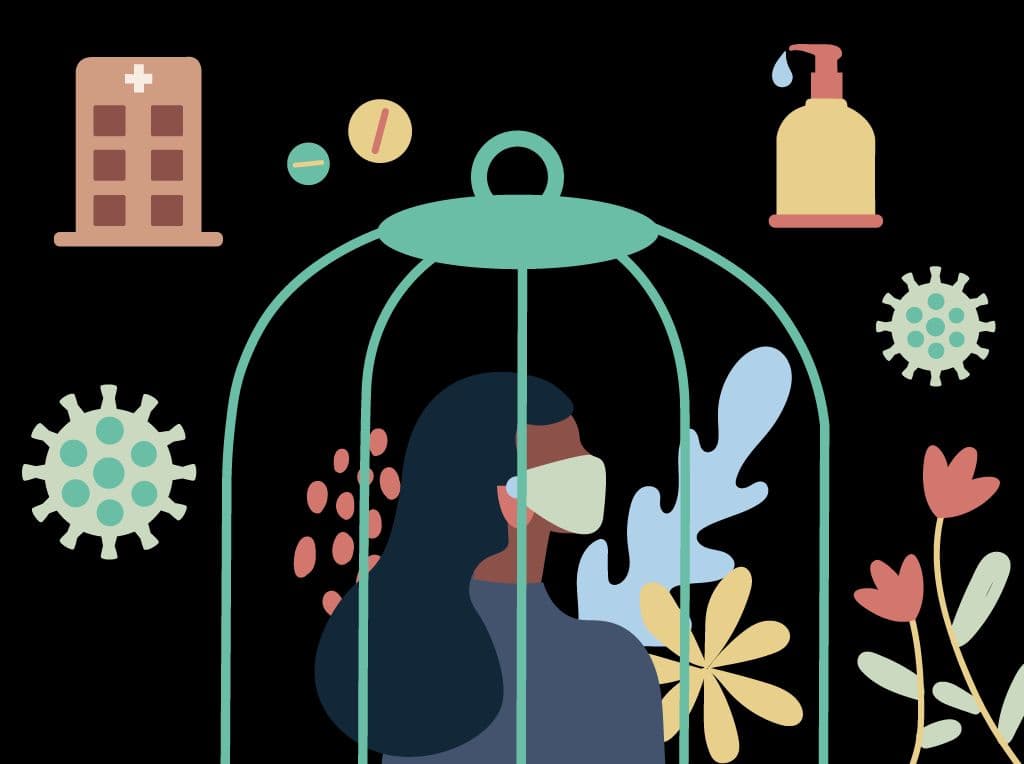In March, India went into a nationwide lockdown to contain the spread of the COVID-19 coronavirus. Only essential services were allowed to continue work during this strict lockdown.
An essential part of the essential services are the media, who work tirelessly to bring news to the public every day. Their work has become more important at a time when the populace is interested in news about the pandemic.
While the pandemic has impacted everyone, a matter not gaining much attention in India is the impact of the pandemic on female journalists. Many of them are on the field, reporting day and night, without any relief.
Journalist Barkha Dutt has been on the road for over 60 days, reporting about the impact of the pandemic, particularly on migrant workers. While Dutt’s twitter feed is full of her reports about the situation in India, occasionally, she sheds light on the impact of field reporting on her health. On April 28, Dutt tweeted that she had learned “to live in her car” and was stocking up on water, food and utensils as she found nothing on the field.
Like Dutt, several female journalists are on the field, and facing challenges unique to women. Neelam Pandey, a journalist with The Print, told Youth Ki Awaaz, a media startup, that the biggest challenges she faces on field are the lack of washrooms for women and dustbins for disposal of menstrual pads.
Some female journalists are being forced to use the washrooms in the houses of the people they interview – putting them in danger of contracting the coronavirus that can survive on surfaces. Female journalists going into remote areas to report during the pandemic are also being forced to relieve themselves in an open field, which is a safety issue, or visit open urinals alloted to men.
In smaller cities of India, women hardly venture out as outdoor activities are strictly restricted to men, so the availability of outdoor washrooms is skewed towards men. This has become a systemic barrier for female journalists, some of whom choose to go for hours without relieving themselves and bleeding into their clothes during their period owing to lack of a women’s washroom to dispose of their pads.
Health – not just physical, but also mental
The mental health of women journalists has also taken a hit during the pandemic. Anxiety and depression has increased in female journalists covering the pandemic. One of the key reasons is an increase in online bullying of women, as people have started spending more time on social media. According to a survey by the International Women’s Media Foundation (IWMF), online attacks have become more visible and coordinated in the past five years, particularly with a rise of nationalism around the world and the use of digital networks to thwart political processes.
Apart from invisible menaces online, there is also the pressure of contracting the coronavirus, and giving it to household members. “There is always the psychological pressure when I go out on field…the guilt that I might be risking the life of my 4-year-old son and my mother-in-law, who fall under the vulnerable segment. Then there is this urge to cover a story. Whether it’s the shamshan ghat (cremation ground) or a hospital mortuary, I have ensured that we have taken extra precautions.
It’s not easy to wear a water-proof PPE kit in this heat. I am sweating through it. I could have ignored the precautions, but considering what is at stake I know if I have to do whatever it takes for the story while keeping my family safe. That balance has to be there”, said Mausami Singh, a journalist with India Today.
News of journalists being booked under the Unlawful Activities Act (UAPA), has also increased anxiety in women. Some female journalists in Indian-administered Kashmir are now filtering stories they wish to cover, as societal and institutional pressure has pushed them to depression.
However, most female journalists are simply forced to keep their grief and depression aside as they report news as distressing as children dying from the coronavirus to migrants committing suicide.
One cannot ignore the ever present guilt of not being a good wife or mother felt by on female journalists. “There are always those who give you unwarranted advice — some are sarcastic. You are constantly judged. There are casual remarks about how I should be at home taking care of my child instead of being in high risk zones covering stories. But women learn to multi-task. For me it’s a routine that after or before covering a story I will run up and down the 16 floors of my high rise building with my child to ensure that he has completed his daily dose of exercise. Women have their feet in both boats. I want to give my 100 per cent in both my professional life and my personal life, but I still hear the sarcastic jibes of how I am neglecting family and over doing it. But now I am used to being judged constantly. I have learned to live with it,” said Mausami.
Job cuts – another great concern
Added to the pandemic is the rampant job cuts in journalism, as countries move into recession, advertising takes a hit, and ad-dependent media firms look set to shut shop.
Women journalists who have lost their job face gender biases in new job searches and are further burdened by the exacting demands of household chores, which rest primarily on the shoulders of women owing to entrenched set gender stereotypes.
The pandemic has also increased gender-discrimination at work for female journalists. According to a report by The Coalition for Women in Journalism (CFWIJ), a US non-profit, discriminatory measures were in place in Indian media houses even before the pandemic but have increased because of it.
Female journalists are being treated unfairly, but are continuing to work because they need a regular income to support their family. Several women journalists were even forced to buy their own protective gear and arrange transport for reporting assignments, even while facing the possibility of a pay cut.
Many female journalists may not even return to the workforce after losing their jobs. “I feel a woman puts everything at stake to continue doing their job. In Indian society, women are the ones who are supposed to bear the responsibility at the home front. There’s always this permanent guilt for not being able to balance both work and home and to constantly prove otherwise.
That said, journalism is a demanding profession and that’s why more women drop out midway through their careers. There’s prolonged pressure at work and while it’s fine for men to throw their weight around the house, women are expected to instantly switch roles and set their house in order. If a woman journalist loses her job mid-career, she might not ever come back because of sheer emotional and psychological pressure. In an environment where resources are limited, jobs are tough and family support is lacking, the more plausible option is to sit at home. The loss to a progressive society is immense,” added Mausami.
As more and more media organizations fire people, particularly women journalists, stories about women have taken a backseat. This is a concern as the existing genderexisting the gender paradigm already pushes women’s voices to the margins.
“Women journalists play a very important role as news-gatherers. They uncover hidden angles and make women’s voices visible. Losing them would set back the gains of the last few decades”, Geeta Seshu, a researcher working on gender issues, told the CFWIJ.
The threat of violence on the field
Challenges for journalists aren’t just internal – exogenous factors also impede their ability to report. The recent protests in the US over the death of an unarmed black man, George Floyd, have again raised the issue of safety for journalists reporting on the field. Several journalists were attacked by the police while on the job. Linda Tirado, a photojournalist, permanently lost the vision in her left eye while covering the George Floyd protests in Minneapolis.
According to an analysis by The Guardian, journalists were assaulted by officers in 34 instances, while there were 33 instances of journalists being arrested or detained during the George Floyd protests.
Reporting in conflict zones is becoming more challenging every day as journalists are becoming collateral damage between clashes. Journalists, more often than not, are seen by institutional elements as impeding their flow of work.
In February 2020, NDTV journalist Mariyam Alavi, along with two of her male colleagues, was attacked by a mob in northeast Delhi, where they were covering riots. Arvind Gunasekar, another NDTV journalist, was cornered by a mob that broke his teeth by hitting him in the face.
An IWMF survey of female journalists from 2018 found that 26% of its respondents had been attacked in 2017-18, while one in 10 respondents had received a death threat. According to the survey, 61% percent of freelance female journalists indicated they were concerned with their physical safety. This group of self-employed journalists is vulnerable as they do not have institutional or peer support and are working on their own.
The coronavirus pandemic has made journalists more vulnerable – as they are held back by institutional regimes – and they are more at risk to catch the virus as they are constantly on the field. If the 53 journalists who tested positive for the coronavirus in Mumbai reveal the profession’s precarious nature – they also reveal the life of insecurity for a journalist, who has to balance a career and surging medical expenses, and the possibility of a job loss, if they contract the virus on the job.

